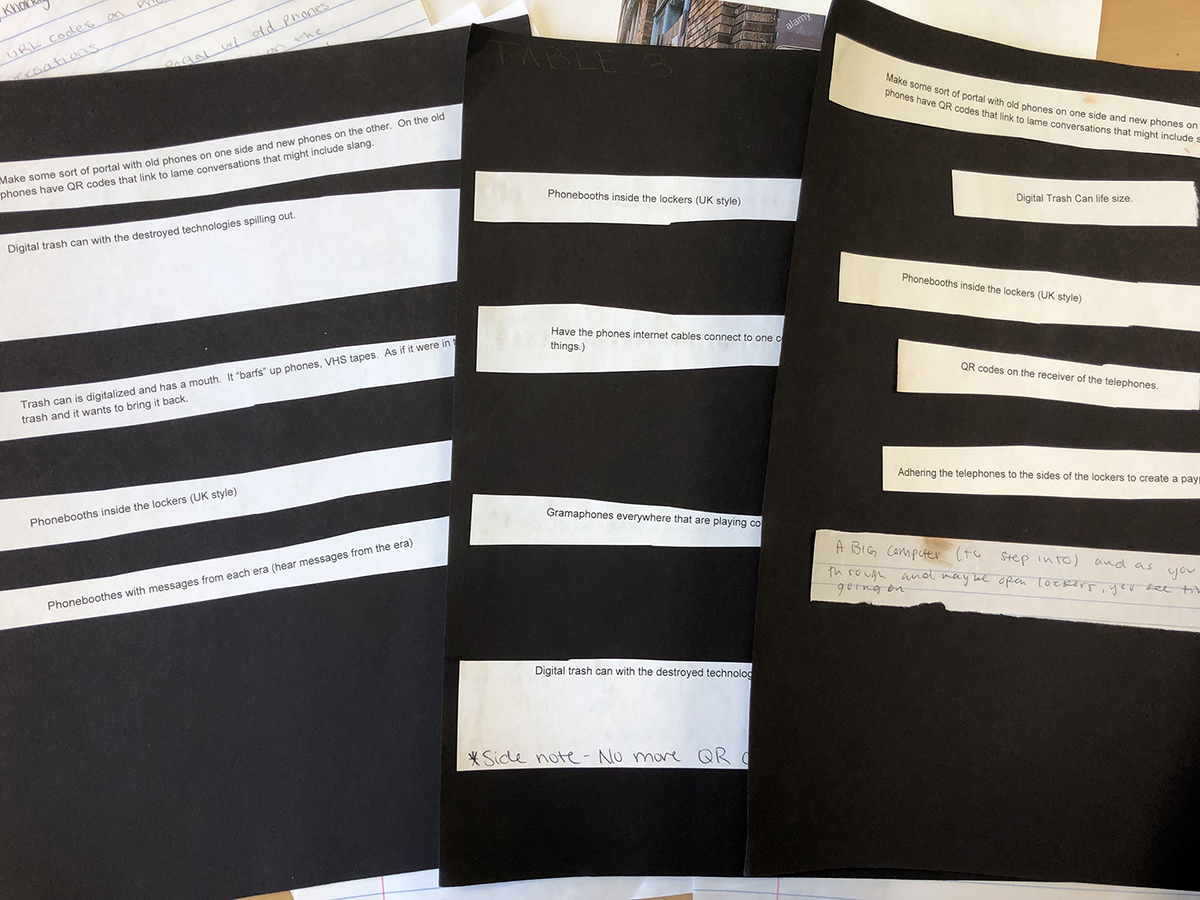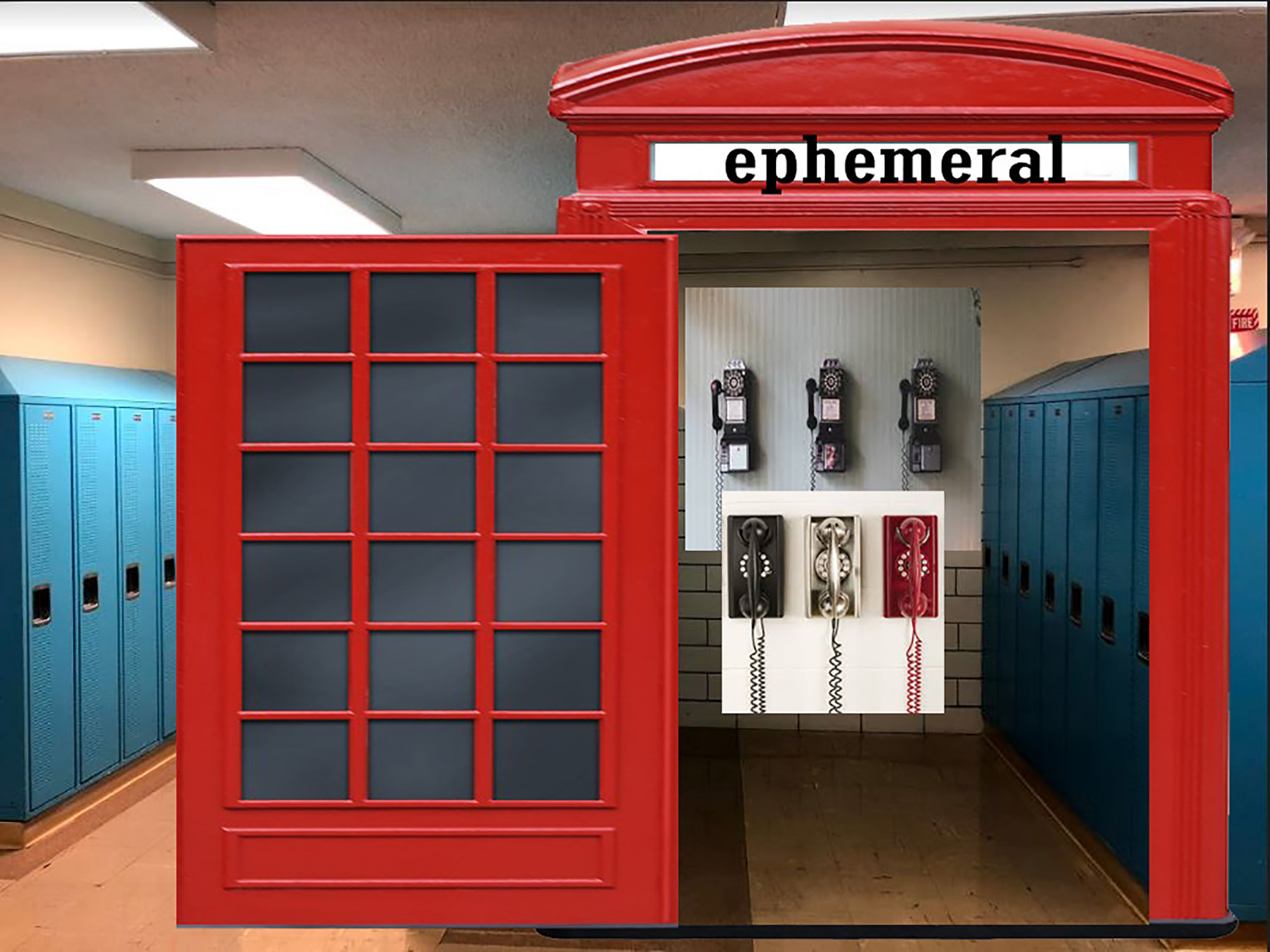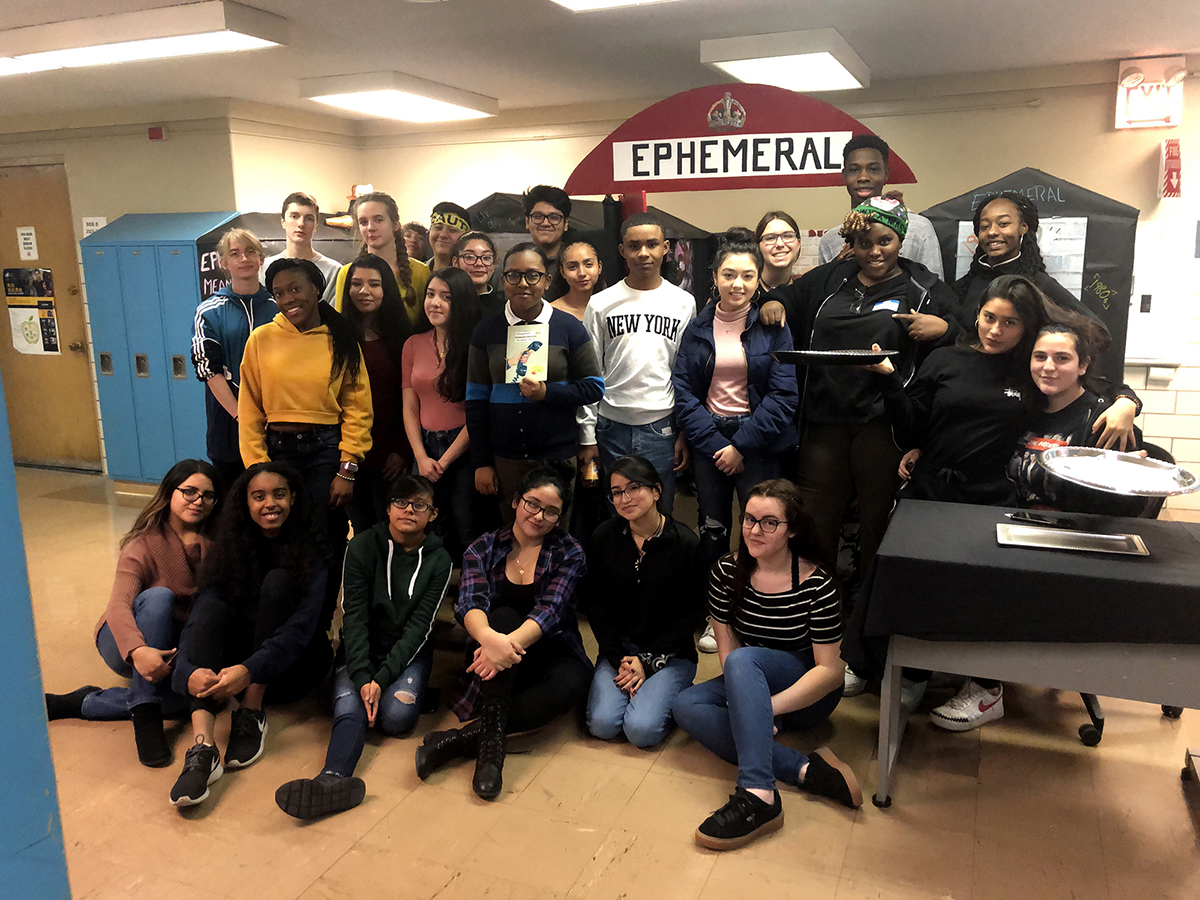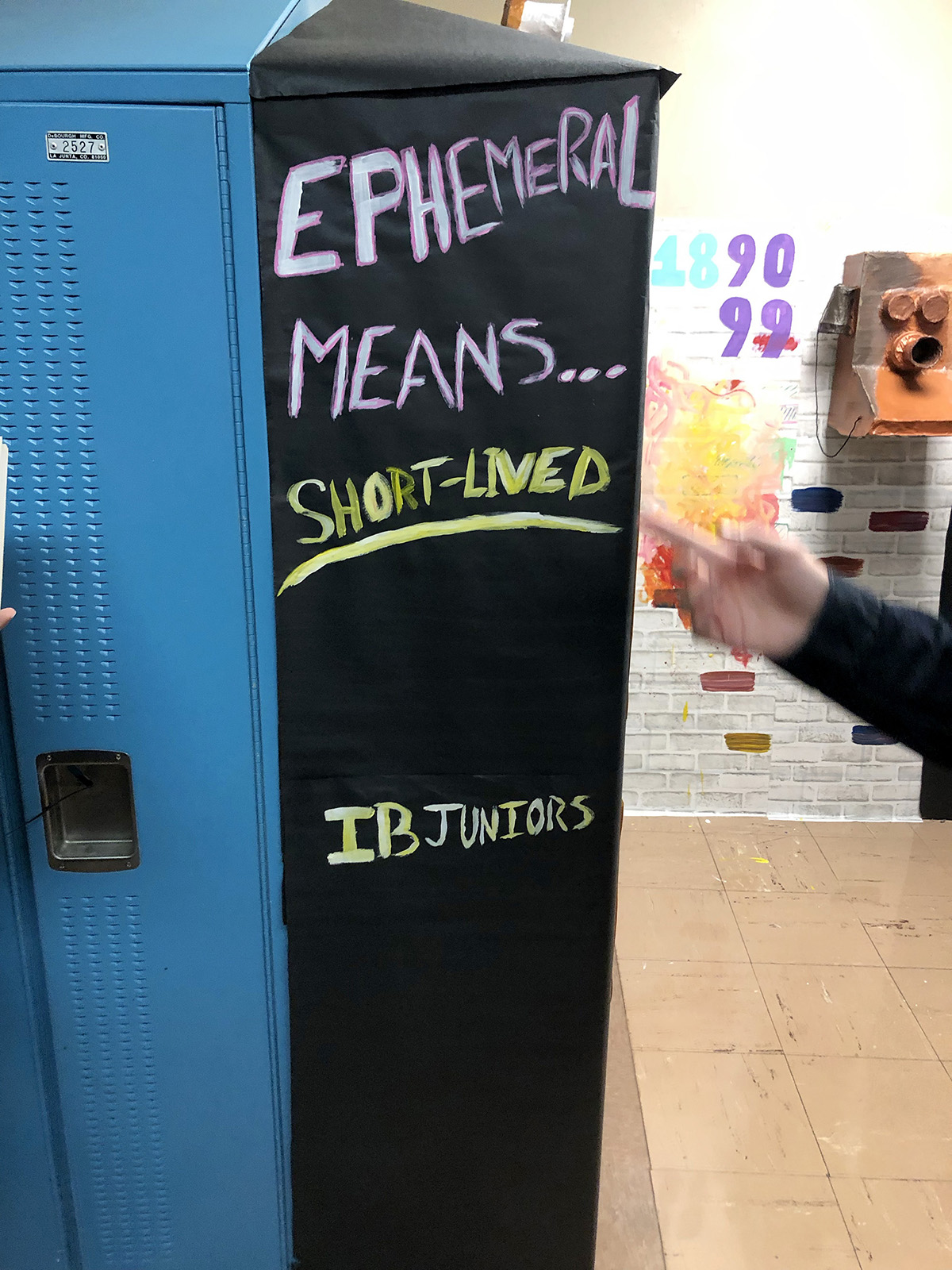Ephemerality and Installation Art
By Annamaria Cabral

This project involved students in an International Baccalaureate Diploma Visual Arts, Year 1 class. All 27 of these students are Juniors. Ogden is a full continuum IB high school in CPS that serves a very diverse population of 675 high school students.

This project is about addressing ephemerality in our current society, and how we can create a community in doing so. The project was student-driven and slowly developed into a collaborative installation. As the project progressed, a community began to form amongst the students as well as among the larger student body audience.
Objectives
- Students will explore the idea of ephemerality.
- Students will develop an installation to be experienced within the school. This objective was based on student group discussions and Google form surveys.
- Students will work collaboratively.
Guiding Questions
- Having grown up in this online age of constant change (MySpace, Snapchat, Instagram, etc.) how can we embrace the ephemeral in a throw-away society?
- What is the cost of convenience?
- Are we addicted to or ignorant of convenience?

Project Overview
We began this project in September and worked on it intermittently through November. We first visited the MCA Chicago exhibition, I Was Raised on the Internet, which included quite a few installations. During my summer residence at the MCA, I developed a guiding question of “How can we embrace the ephemeral in a throwaway society?” in response to the exhibition. Students considered this question as they experienced the exhibition, photographing images of artworks that truly spoke to them.
In order to help build our student community, I introduced an activity on listening and building, inspired by the artist Cecil McDonald’s work. We looked at Candy Cigarette by Sally Mann and independently created narratives based on what we saw within the image. Students picked a portion of their narrative to share with the group, and we recorded our responses. We reflected as a class by listening to the recordings and sharing written responses on the whiteboard and in our sketchbooks.
Students reflected on these experiences and collectively decided they wanted to explore the idea of the ephemeral more deeply and examine how the term related to different generations. We considered how objects from earlier time periods might be interpreted today by playing a reflection game of This is a What? In this game, students are as creative as possible when describing an object. For example: If I pick up a fork and say, "This is a what?” any response except “this a fork” would be correct—"this is a comb,” “this is an oar,” or “this is a lightning rod.” We developed word webs to visually capture our brainstorming session on objects, which led us to identify telephones as good representative objects of ephemerality because of their connection to the World Wide Web, conversation, and information retention (Did you know that you only retain 10% of a conversation unless really invested?).
We visited a thrift store to explore older versions of cell phones and landline phones, sketched out these phones, and played the game of telephone. We began researching phones throughout the decades and how they affected communication, specifically for teenagers. Students were fascinated by teenage culture and slang from different time periods, such as “far out,” “lettuce,” (money) and “wisenheimer” (arrogant jokester).
The students led a discussion about how they could visually convey their research of phones, communication, and ephemerality. They decided the main focus of this project should be conversation, and considered how to use phones as a symbol of the ephemeral quality of conversation. They settled on a collaborative, publicly-interactive installation that would be ephemeral in itself. We searched for locations in the building, voted on a location, and photographed it. We then created sketches and proposal forms for transforming the space, critiqued the proposals and sketches, and settled on one installation concept in particular: We would create a phone booth styled installation with tagged quotes and sculptural representations of phones from specific decades. Students would also record conversations that mimicked the tagged quotes, which audience members would hear when they stepped into the phone box.
The students paired off to sculpt and paint papier-mâché larger-than-life phones from historical decades, inspired by Rob Pettit’s work with recycled phones. A group of three students created the phone box construction. All students researched 10 historical facts during their selected time period, why the phones looked the way they did, and 5 fun facts that affected teenagers. This research facilitated the tagging and recording of sounds of popular sayings that might have historically been spoken over the phone. All of the sounds played simultaneously via a cheap greeting card recorder/playback device, which was activated as visitors passed through the phone box.
We then presented the installation to students in other classes for the opening day with “hors d'oeuvres” (sheets of paper with the term printed on them). The audience was very receptive and asked a lot of questions, but they were most interested in hearing the recordings in the main phone booth entry and taking selfies up against it.
We reflected on the project as a class and talked about students’ interaction with the space. We noted how students taking selfies in the space documented the experience and captured the ephemeral quality of the project. Students had deliberately selected the location for the installation, anticipating it would be damaged and fall apart over time, emphasizing ephemerality. However, the installation stayed in place for a while, and other students were more respectful than anticipated, revealing the inaccuracy of our notions and expectations.


Materials
- Thrift store phones
- Sketchbooks
- Paper
- Papier-mâché Glue
- Contact Paper
- Bulletin board paper
- Paint markers
- Paint
- Duck Tape
- 3M Strips
- Found objects—in particular, cardboard to form armature
- Hot Glue
- Hog Glue Sticks
- 3 Sound recorder (purchased on Amazon for $3.99 each. It records 90 seconds of sound.)
MCA Connections
Our class field trip to the MCA began our investigation of ephemerality in response to contemporary artworks. We viewed the exhibition I Was Raised on the Internet and spent considerable time discussing the works of Amalia Ulman, Evan Roth, Eva and Franco Mattes, Constant Dullaart and other artists in the show. These works prompted our investigation of the term ephemeral as we talked about things that we throw away: ideas, physical items, toys, technology, clothes, food, apps, etc. Back in the classroom, we connected the messages in Bogosi Sekhukhuni’s Consciousness Engine #2: absentblackfatherbot to the works of other contemporary artists, most notably Suzanne Lacy’s The Roof is on Fire.

References + Resources
Annamaria Cabral
Annamaria Cabral
About Annamaria Cabral
Annamaria Castellucci Cabral is an IB high school visual arts teacher at Ogden International in Chicago Public Schools. She graduated with a BA in Photography and a minor in Theatre Arts from Dominican University which allowed her to both study abroad in Florence and work as a set designer all across the city. Annamaria then went on to attend Columbia College of Chicago and earn a Master of Arts in Teaching where she gained a great affinity for printmaking, alternative photographic processes, and mixed media. She began teaching workshops at local art leagues and later taught in both public and private institutions. She believes that art is a universal language that can both challenge and excite students. She has a deep love for both contemporary and outsider art, current events, and Instagram (which she often incorporates into her curriculum).
Annamaria Reflects on the Project
The hallelujah moment of the project was when the students were almost done with their papier-mâché phones and the phone booth was going up. One student said, “Oh my gosh . . . it is looking like our sketch.” That was lovely to witness. Students really enjoyed the installation and embraced its ephemeral quality because to them it meant that it was okay if the installation did evolve, change, or get destroyed—and perhaps this even alleviated a little pressure. The students also became really attached to their decade and the things that teenagers were going through during those periods of time.
The biggest obstacle was getting all of the students to agree without me taking control of the situation. The students assumed I had the final say at the very beginning, but once the unit gained traction, they understood they were the driving force behind this collaborative piece. There were several moments where I found myself biting my tongue. For example, the phone box was a contentious discussion, because although we do not live in the UK, the overall consensus within the class was that teenagers in this generation related more to a Dr. Who-inspired UK phone box instead of an Illinois Bell phone booth. I also had to embrace being uncomfortable with lots of materials flying around, which was different for me.
If I started this project over again, I would consider other ways to approach the brainstorming process. Surveys, although helpful, did not really gain any traction. The students brainstormed better verbally, but this also meant that much of my energy during this time was spent encouraging the students to vocalize their thoughts. I would consider having some different exercises such as sentence stems to initiate written feedback and enhance the conversation. In the end, we all enjoyed the process and engaged in lots of great conversations amongst ourselves and with other people about the work.
